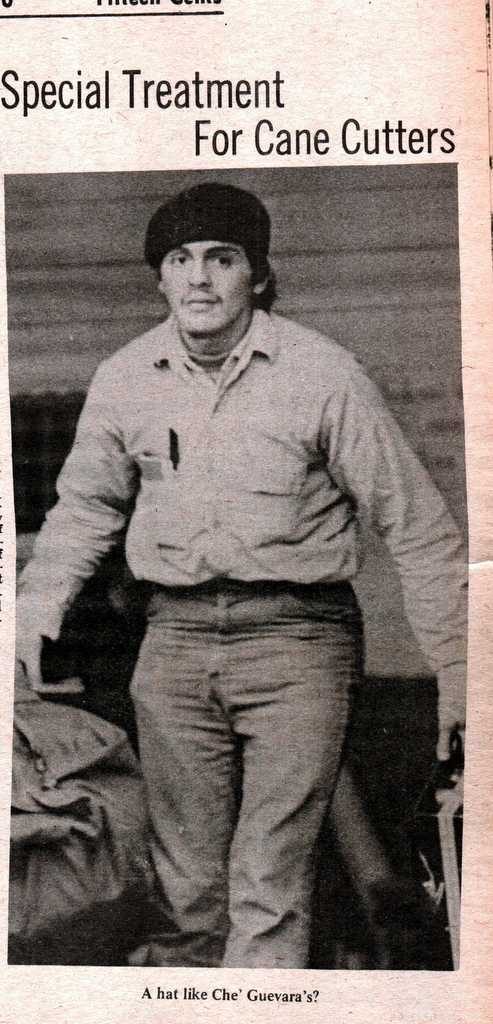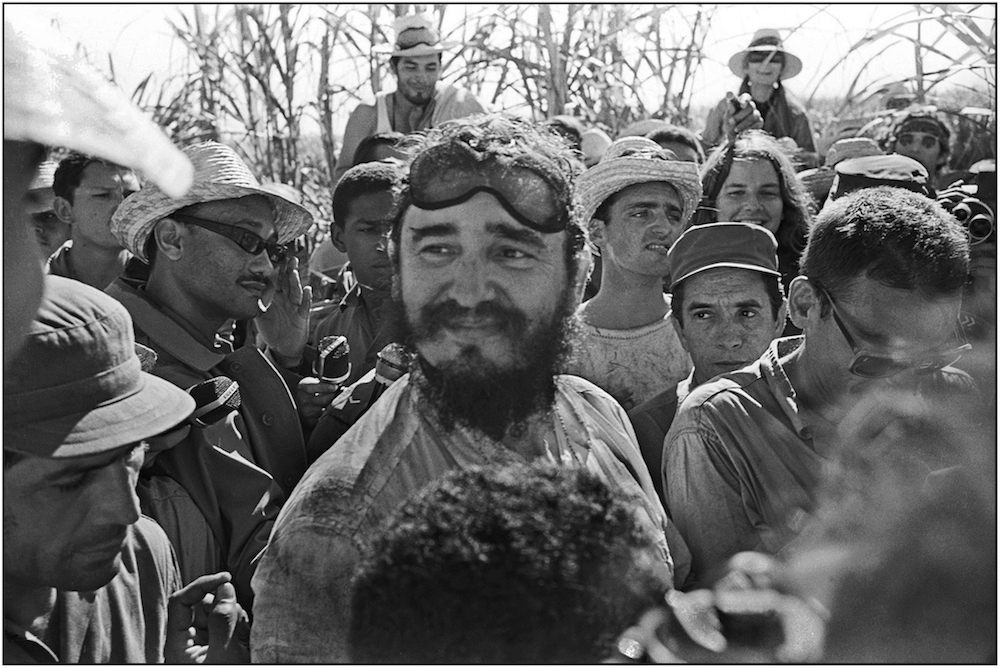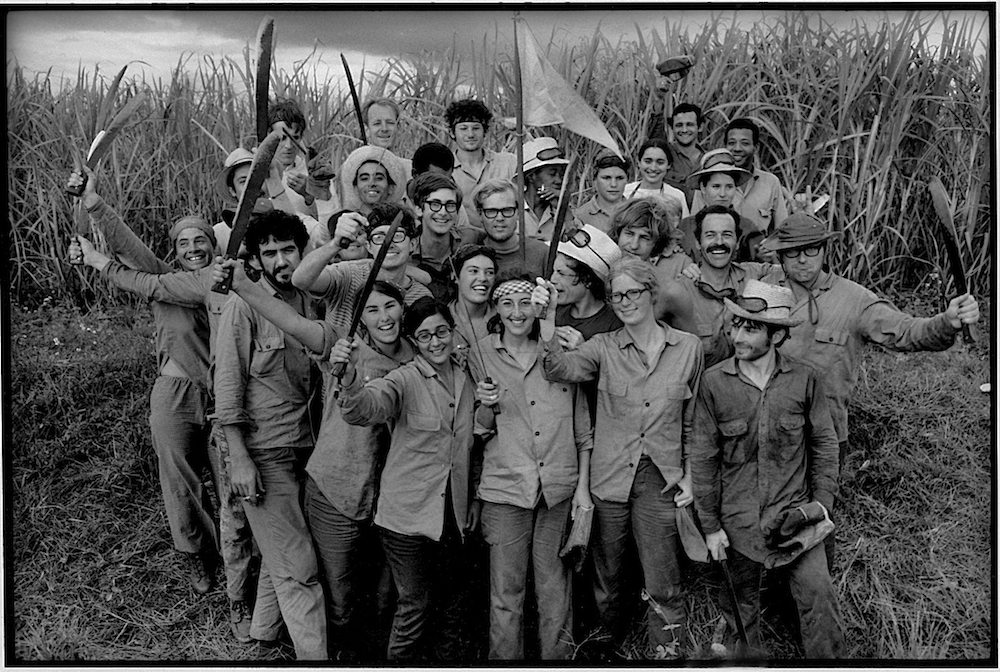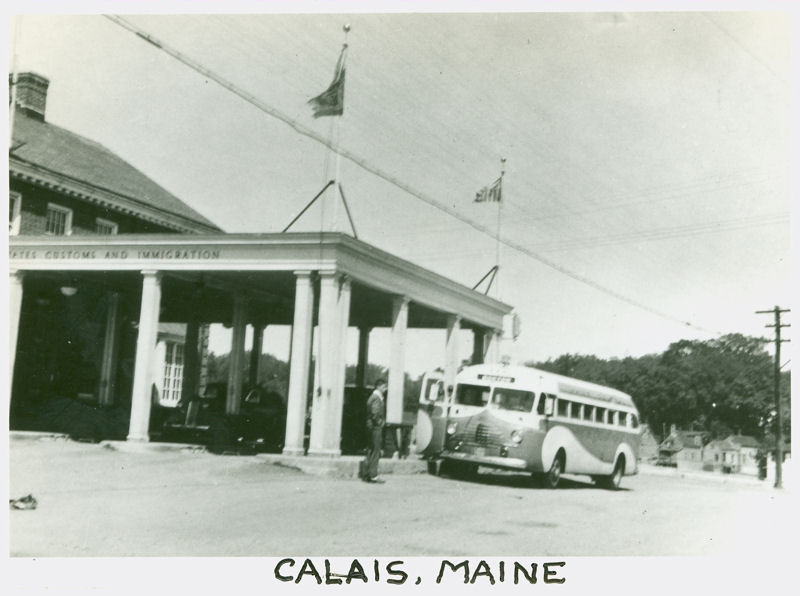In the spring of 1970, Calais found itself on the front lines of the political battle over the war in Vietnam and Fidel Castro’s Cuba. If Senator John Eastland of Mississippi and chair of the Senate “Internal Security Committee” were to be believed, the tip of the spear of Communist revolution had been thrust into the heart of America at the Calais border crossing in 1970 when hundreds of American leftist “cane cutters” crossed the border into the United States after being “indoctrinated and trained” to wage revolution under the guise of assisting Fidel Castro harvest Cuba’s sugar cane crop.
Eastland, who was known as the “Voice of White South” and had famously said during World War 2 that “boys from the South were fighting to maintain white supremacy” had a large following on the right and his warning about the “cane cutters” was taken seriously by much of the press.

The Advertiser was on hand to document the invasion, featuring the photo of a “cane cutter” who, had he sported a beard and sideburns, could have easily been mistaken for Che Guevera. The caption under the photo indicated the Advertiser had suspicions about this group:
Last week approximately 400 Americans returned to the United States after helping Fidel Castro with his Cuban sugar crops.
Surrounded by mystery and international intrigue these young Americans were tight lipped and not willing to share any of their cane cutting experiences. The leader of the group told the travelers to cooperate and not to give the officials any static.
The Canadian government, grim over the recent trouble in Quebec, treated the Americans in a stern military manner and photographed all the young leftists. Then the Mounties escorted four large cross country busses to St. Stephen where they crossed into Calais. Besides the busses some 40 cars picked up a share of the sugar cane cutters.
At the Calais bridge, the group was completely mum and as they were cleared through customs they entered once again their busses for the trip to such cities as San Francisco, Los Angeles, Denver, St. Louis and New York City. In keeping with the shady overcast of the whole trip, the busses which were hired out of Montreal are paid for completely by an unknown source in New York City.
Grubby and shaggy looking, and many carrying medicine for a common parasite known as a “crab”, have these neophytes in the story of life returned to the United States of America to help our Great Society, or perhaps to recruit more help for Communist Cuba? Many people would like to know the answer?
This group, which actually numbered 200, had disembarked from a Cuban freighter in Saint John, N.B. earlier that day after a several day voyage from Cuba. 600 other Americans were on hand in Saint John to board the freighter to replace those returning from the cane fields. Newspapers throughout the country reported on the return of the can cutters.
The State – Columbia, South Carolina; February 13, 1970:
200 Youths Return From Cuban Fields
SAINT JOHN NB (AP) –
More than 200 American youths disembarked Thursday after a stormy ocean voyage back from several months of cutting sugar cane in Cuba. Some 600 other young Americans prepared to sail to take their place.
The Cuban freighter Luis Arcos Bergnes arrived at the New Brunswick port after riding out a heavy sleet and snowstorm The bitter weather left the youths lightly clad for work in the topical fields shivering Fidel Castro Cuban prime minister has pledged the honor of his country to harvest a record 10 million tons of sugar this year. But in a television speech last Monday he admitted the harvest had run into trouble because of equipment delays and unfavorable weather. Castro worked in the fields with the American group one day said Gerry Simon 20 of New Orleans
Returning youths told those waiting to leave that they worked seven hours a day and spent most of their free time reading or talking. Some of the youths who returned from Cuba boarded chartered buses including some of those which had brought their replacements to Canada for the United States Thursday. The exact route of the buses was not known except that they planned to enter the United States at the St Stephen-Calais Maine port of entry. Other returnees told newsmen they planned to fly from Saint John to the United States “We came back understanding better than ever the necessity for total destruction of United States imperialism” said Patricia Bouchard 28 of Chicago a spokesman for the returning group. The US press “has told vicious lies that we have received military training in Cuba” she said “This is not the first time a group of Americans have gone to work to show solidarity with the Cubans” she added. Miss Bouchard also said groups from several other countries were in Cuba to help with the sugar harvest and “we had a very friendly meeting with the people of the North Vietnamese delegation” (AP Wirephoto)
Some background may be helpful. The “cane cutters” were members of the Vereremos Brigade – roughly translated as We Shall Prevail – which was an offshoot of the Student for a Democratic Society (SDS), a group which championed leftist causes and was mainly known for its opposition to the war in Vietnam.
The SDS passed up no opportunity to poke a stick in the eye of the Nixon Administration and nothing unhinged Nixon’s “Silent Majority” more than war protesters, except, perhaps, war protesters who took a break from protesting to pick Fidel’s sugar. In truth Fidel probably didn’t need the Brigade to harvest the cane and the American public had nothing to fear from their return but in the polarized climate of 1970 both sides saw an opportunity to, as they now say in internet lingo, flame the other.


Fidel, of course, basked in the attention the press focused on the Brigade, even spending a day with them in the cane fields. The U.S. press covered the cane cutters extensively, many newspapers warning of the dangers these “revolutionaries” posed to the country when they returned.
The Bangor Daily was more subdued than many newspapers. The paper reported on the return of the cane cutters and the outgoing group on February 13.
Bangor Daily; February 13: (Special to the NEWS)
SAINT JOHN, N.B. – Shivering in cold winds gusting up to 40 miles an hour, sleet and snow, close to 700 young Americans greeted each other on the Saint John waterfront Thursday morning. Approximately 200 members of the group arrived in port shortly after 7 a.m. Thursday aboard the Cuban freighter Luis Arcos Bernes which tied up at pier 14 on the west side of the harbor. The remaining 500 young people many of them students were awaiting the arrival of the ship aboard chartered buses parked at the dockside. The buses began arriving in the city shortly after 4 a.m. Thursday following a 450-mile journey from Boston.
The first passengers to leave the ship began disembarking shortly before 10 a.m. and brigade organizers said earlier that they were hopeful the vessel would sail for Cuba by Thursday night. Both those aboard the ship and those aboard the buses were cheerful and friendly Thursday morning and jokingly bantered with the many newsmen who milled about the dockside. But they were suspicious of the reporters and made sure the questions and answers flowing back and forth were of a general nature. “How cold is it here?” Yelled one young man from the deck of the freighter. “It was sure a lot warmer than this where we just came from.” One girl, probably in her early 20s, leaned over the rail of the freighter dressed in a parka and scarf wrapped around her head. “We left Havana Harbor early Friday morning,” she said. “We ran into rough weather late Tuesday and a lot of the kids got pretty seasick. But I think most of them are 0K now.”
‘Expect No Difficulty’
Most of those aboard the freighter didn’t expect any difficulties at the U. S. Canada international boundary at Calais, as they re-enter the United States aboard the chartered buses scheduled to leave Saint John sometime Thursday. About 127 returning youngsters from Cuba cleared U.S. Immigration authorities at Calais at 6:33 p.m. Thursday. However, the group was not expected to clear customs before 10 p.m. Immigration authorities in St. Stephen allowed the buses to cross with the normal check administered to any American entering this country. An executive member of the Brigade, Bruce Jacobs of New York City, in Saint John Wednesday said that all members of the brigade had been forewarned “to tell immigration officials at the border the truth, their destination and the purpose of their trip.” Those aboard the ship for the six-day trip from Cuba said it was uneventful except for the rough weather encountered as the vessel neared Saint John. ‘It was a great trip up. A great ship,” commented one of the passengers from the railing of the freighter. “It was kind of rough the last day, but I think everyone was used to it by then.” He said the 200 brigade members played cards, watched movies and just talked to pass the time. “Great Time. It was a great time in Cuba, said another young man. “I wanted to stay there but we had to come back home.” Most of the passengers aboard the freighter simply turned their backs if the talk between the dockside and the vessel’s deck changed to more meaningful questions. One of the group did say as he walked along the dock, carrying his knapsack after clearing Immigration, that he thought the trip was worthwhile. “We cut a lot of sugar cane,” he said as he smiled. Jacobs said in Saint John Wednesday night that the brigade was organized following a meeting in New York City during September. Their aim is to aid in this year’s sugar cane harvest so that the “country will be able to mechanize future harvests.”
Kent Ward, a long time columnist of The Bangor Daily, interviewed some of the returnees when they passed through Bangor on the 14th of February. He was unimpressed and suspicious of the Brigade.
Ward described them being “on their way back from home after six weeks in Cuba supposedly spent harvesting sugar cane for Castro for free. But judging from their tender appearing hands, many of them didn’t harvest a whole lot of sugar cane.” He went on to ponder “Where did it all start? When will it all end? Were the parents somewhere along the line too permissive? Would a good kick or two in the pants have helped…?” He went to admit however that the evening he spent talking with the Brigade it wasn’t a complete waste – “No one took their clothes off in public.”
Other newspapers expressed more alarm than Kent Ward although the evidence of the “revolutionary training” it provided was based on unnamed officials and reports of whites speaking English seen in areas associated with military activities while admitting that “their dress bore no resemblance to that worn” by the cane cutters. Further a reporter who had accompanied the group observed no military training. Typical was an article published by the Detroit News when the group which left Saint John for Cuba on February 13th returned. It was widely reprinted around the country. This group also returned through Calais.
Nashville Tennessean; March 22, 1970:
Guise of Cutting Cane Cuba Training U.S. Youth. For Revolution:
Report From THE DETROIT NEWS DETROIT
Almost certain proof that large numbers of young American radicals are being trained in Cuba for revolutionary warfare in their homeland has been unearthed by the Detroit News. The evidence concerns a charge made, but left largely unsupported, last Monday in Washington by Sen. James O. Eastland, chairman of the Senate internal security subcommittee. The Mississippi Democrat asserted that nearly 1000 youths who have visited Cuba ostensibly to cut sugar cane have been “indoctrinated and trained” to wage revolution in the United States. As evidence the following story about the American youths who have visited Cuba under the guise of cutting sugar cane, and what their activities allegedly were, was carried in this morning’s edition of the Detroit News, cited names of hippies and anti-Vietnam war leaders who had been to Cuba and said the Cubans really need no help in harvesting their sugar.
Randall Richard, a reporter for the Providence, R.I., Journal, who went with 700 young Americans last month for the sugar harvest, told THE NASHVILLE TENNESSEAN by telephone last night that he saw no efforts by the Cuban government to train the Americans in guerrilla warfare, but said that he had to leave the group prematurely. Richard’s copyrighted story on what he did see is on page 6A. A high-ranking Canadian government source has now told the News that most of the 500 American youths presently in Cuba are, in fact, learning revolutionary warfare at a site 30 miles east of Havana. He said they are being taught by instructors from Red China and perhaps the Soviet Union. The training site is also used to prepare guerillas for export to Latin America.
Nearly 40 of the Americans are believed to be from the Detroit area and other parts of Michigan, the source said. The information was taken from classified reports from several free world consulates in Havana that serve as listening posts for the United States and Canada. The training of American radicals apparently has been going on for at least six months. It was accidentally discovered last fall when a West European Consulate, invited to the site to review Cuban militia operations, was inadvertently driven into the area where the Americans were being trained. In a report to his government, the consulate member identified the trainees as Americans beyond reasonable doubt. A large number were blue-eyed blondes, he reported, and he overheard many speaking English. His report was supported on several occasions by consulate members of other countries who observed American youth in paramilitary attire in small towns and villages near the site. Their dress reportedly bore no resemblance to that worn by Americans who have been photographed cutting sugar at Camp Venceremos in eastern Havana. The majority of the Americans now in Cuba were recruited in the United States earlier this year and embarked from St. John’s, N.B., Feb. 13, aboard the Cuban cattle boat, the Luis Arco Dergenas. Canadian authorities reported that 480 Americans, most of them college students in their early 20s, boarded the cattle boat as part of the Venceremos ‘ Brigade volunteers allegedly recruited by the Castro government to harvest sugar cane. A smaller contingent of American volunteers reportedly flew about the same time to Havana from Mexico City on Cubana Airlines. Canadian officials also counted 212 persons disembarking from the Luis Arco Dergenas at New Brunswick after their return from Cuba. All but one Canadian were American citizens, they said. Most of the new arrivals rode buses back to the United States, crossing the border at St. Stevens, N. B., and Calais, Maine. The Group went through only a routine luggage check at St. John’s, Canadian authorities said, but were subjected to a rigorous search by U. S. Customs agents when they crossed into Maine. No weapons were found at that time, but customs officials did confiscate a large amount of revolutionary literature, including detailed plans for the production of Molotov cocktails and highly sophisticated dynamite devices. Canadian officials say they are “very alarmed” over what they consider the odds-on-probability that most of the returning Americans have been trained for violent revolution. But they point out that there is little they can do as long as no Canadian laws are violated. American citizens may enter Canada without passports, but must show proper identification of place of birth and current residence, usually a birth certificate and driver’s license.

At Calais Customs, the cane cutters were always given special attention. All were thoroughly searched and no weapons were found. While this is not surprising, it is odd, given the times that no illegal drugs were found and you can be sure that none would have gotten by Customs Inspector Harold Hovey who waged a decades long crusade against “hippies” and was reported to be able to spot a marijuana seed even if hidden under a car’s floor mat.
The job of customs inspection of the Brigade was actually very easy. Nearly everything other than the clothes on their backs was confiscated including diaries, photos, books and souvenirs. The port director at Calais in 1970 was Charlie Copp and Charlie was a decent, sensible fellow so likely the order to confiscate everything on the dubious pretext that Brigade members didn’t have an “import permit” came from on high. Years later the large storage room on the second floor of customs was lined with racks weighted down by the sheer volume of this confiscated material which it is claimed contained instructions for making bombs.
Perhaps confiscation was a sound measure as members of the Venceremos Brigade, having lost their bomb making instructions, didn’t blow up even one post office or federal building, as far as we can tell, nor did they assault the capital. Many surely organized and marched in hundreds of Vietnam War protests but even then they were soon marginalized when Nixon’s “silent majority” found its voice and demanded an end to the Vietnam War.
By September of 1970, a solid majority of Americans were demanding withdrawal from Vietnam and more protests were being organized by grandmothers than the SDS. In fact some “brigadistas” as they were called seemed to have gone mainstream. One was elected to Congress, Antonio Villaraigosa became the mayor of Los Angeles and others were in later years college presidents and noted authors. Jeffrey Klien founded Mother Jones magazine. Not all remained admirers of Fidel’s “Worker’s Paradise”. Allen Young, one of the Brigades organizers, became a staunch critic of Cuba and wrote extensively on the failures of Castro’s “Worker’s Paradise.”
